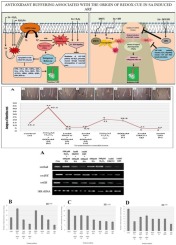当前位置:
X-MOL 学术
›
J. Plant Physiol.
›
论文详情
Our official English website, www.x-mol.net, welcomes your feedback! (Note: you will need to create a separate account there.)
The interaction of reactive oxygen species and antioxidants at the metabolic interface in salicylic acid-induced adventitious root formation in mung bean [Vigna radiata (L.) R. Wilczek]
Journal of Plant Physiology ( IF 4.3 ) Pub Date : 2020-05-01 , DOI: 10.1016/j.jplph.2020.153152 Durga Kora 1 , Soumen Bhattacharjee 1
Journal of Plant Physiology ( IF 4.3 ) Pub Date : 2020-05-01 , DOI: 10.1016/j.jplph.2020.153152 Durga Kora 1 , Soumen Bhattacharjee 1
Affiliation

|
Implications of the role of antioxidant buffering in reactive oxygen species (ROS)-antioxidant interactions and associated redox regulation during adventitious root formation (ARF) were assessed in redox-manipulated salicylic acid (SA)-treated hypocotyl explants of mung bean [Vigna radiata (L.) R. Wilczek]. Application of pro-oxidant H2O2 (500 μM) followed by SA (600 μM) was shown to stimulate ARF, whereas treatments combining 600 μM SA and 10 × 10-4 M DPI (diphenyleneiodonium, an inhibitor of NADPH-oxidase) and 600 μM and SA 10 × 10-4 M (dimethylthiourea, a free radical scavenger) were found to prevent ARF. The redox status of the experimental explants monitored under such treatment conditions (in terms of accumulation of pro-oxidants, in situ localization of O2- and H2O2, radical scavenging property and total thiol content) revealed significant changes in ROS-antioxidant interactions at the metabolic interface, causing alterations in the pattern of ARF. Further, the assessment of activities and transcript abundance of the enzymes of the H2O2 turnover pathway (mainly the ascorbate-glutathione system) supported the transcriptional regulation of genes such as vrrboh, vrAPX, vrGR, vrSOD, and vrCAT and the activities of the relevant enzymes necessary for the generation of endogenous redox cues during ARF. The present work provides an inventory in support of the importance of antioxidant buffering associated with redox regulation for the origin of the metabolic redox cue (redox signal) necessary for SA-induced ARF in mung bean.
中文翻译:

水杨酸诱导绿豆不定根形成过程中活性氧和抗氧化剂在代谢界面的相互作用 [Vigna radiata (L.) R. Wilczek]
在氧化还原处理的水杨酸 (SA) 处理的绿豆下胚轴外植体中评估了抗氧化缓冲在活性氧 (ROS)-抗氧化剂相互作用和不定根形成 (ARF) 过程中相关氧化还原调节中的作用 [Vigna radiata ( L.) R. Wilczek]。应用促氧化剂 H2O2 (500 μM) 和 SA (600 μM) 被证明可刺激 ARF,而结合 600 μM SA 和 10 × 10-4 M DPI(二亚苯基碘,NADPH 氧化酶抑制剂)和 600 μM 的治疗和 SA 10 × 10-4 M(二甲基硫脲,一种自由基清除剂)被发现可以预防 ARF。在这种处理条件下监测的实验外植体的氧化还原状态(在促氧化剂的积累、O2-和 H2O2 的原位定位方面,自由基清除特性和总硫醇含量)揭示了代谢界面处 ROS-抗氧化剂相互作用的显着变化,导致 ARF 模式的改变。此外,对 H2O2 转换途径(主要是抗坏血酸-谷胱甘肽系统)的酶的活性和转录丰度的评估支持了 vrrboh、vrAPX、vrGR、vrSOD 和 vrCAT 等基因的转录调控以及相关酶的活性在 ARF 期间产生内源性氧化还原信号所必需的。目前的工作提供了一个清单,以支持与氧化还原调节相关的抗氧化缓冲对于 SA 诱导的绿豆 ARF 所必需的代谢氧化还原信号(氧化还原信号)的起源的重要性。导致 ARF 模式的改变。此外,对 H2O2 转换途径中酶(主要是抗坏血酸-谷胱甘肽系统)的活性和转录本丰度的评估支持了 vrrboh、vrAPX、vrGR、vrSOD 和 vrCAT 等基因的转录调控以及相关酶的活性在 ARF 期间产生内源性氧化还原信号所必需的。目前的工作提供了一个清单,以支持与氧化还原调节相关的抗氧化缓冲对于 SA 诱导的绿豆 ARF 所必需的代谢氧化还原信号(氧化还原信号)的起源的重要性。导致 ARF 模式的改变。此外,对 H2O2 转换途径(主要是抗坏血酸-谷胱甘肽系统)的酶的活性和转录丰度的评估支持了 vrrboh、vrAPX、vrGR、vrSOD 和 vrCAT 等基因的转录调控以及相关酶的活性在 ARF 期间产生内源性氧化还原信号所必需的。目前的工作提供了一个清单,以支持与氧化还原调节相关的抗氧化缓冲对于 SA 诱导的绿豆 ARF 所必需的代谢氧化还原信号(氧化还原信号)的起源的重要性。vrGR、vrSOD 和 vrCAT 以及在 ARF 期间产生内源性氧化还原信号所必需的相关酶的活性。目前的工作提供了一个清单,以支持与氧化还原调节相关的抗氧化缓冲对于 SA 诱导的绿豆 ARF 所必需的代谢氧化还原信号(氧化还原信号)的起源的重要性。vrGR、vrSOD 和 vrCAT 以及在 ARF 期间产生内源性氧化还原信号所必需的相关酶的活性。目前的工作提供了一个清单,以支持与氧化还原调节相关的抗氧化缓冲对于 SA 诱导的绿豆 ARF 所必需的代谢氧化还原信号(氧化还原信号)的起源的重要性。
更新日期:2020-05-01
中文翻译:

水杨酸诱导绿豆不定根形成过程中活性氧和抗氧化剂在代谢界面的相互作用 [Vigna radiata (L.) R. Wilczek]
在氧化还原处理的水杨酸 (SA) 处理的绿豆下胚轴外植体中评估了抗氧化缓冲在活性氧 (ROS)-抗氧化剂相互作用和不定根形成 (ARF) 过程中相关氧化还原调节中的作用 [Vigna radiata ( L.) R. Wilczek]。应用促氧化剂 H2O2 (500 μM) 和 SA (600 μM) 被证明可刺激 ARF,而结合 600 μM SA 和 10 × 10-4 M DPI(二亚苯基碘,NADPH 氧化酶抑制剂)和 600 μM 的治疗和 SA 10 × 10-4 M(二甲基硫脲,一种自由基清除剂)被发现可以预防 ARF。在这种处理条件下监测的实验外植体的氧化还原状态(在促氧化剂的积累、O2-和 H2O2 的原位定位方面,自由基清除特性和总硫醇含量)揭示了代谢界面处 ROS-抗氧化剂相互作用的显着变化,导致 ARF 模式的改变。此外,对 H2O2 转换途径(主要是抗坏血酸-谷胱甘肽系统)的酶的活性和转录丰度的评估支持了 vrrboh、vrAPX、vrGR、vrSOD 和 vrCAT 等基因的转录调控以及相关酶的活性在 ARF 期间产生内源性氧化还原信号所必需的。目前的工作提供了一个清单,以支持与氧化还原调节相关的抗氧化缓冲对于 SA 诱导的绿豆 ARF 所必需的代谢氧化还原信号(氧化还原信号)的起源的重要性。导致 ARF 模式的改变。此外,对 H2O2 转换途径中酶(主要是抗坏血酸-谷胱甘肽系统)的活性和转录本丰度的评估支持了 vrrboh、vrAPX、vrGR、vrSOD 和 vrCAT 等基因的转录调控以及相关酶的活性在 ARF 期间产生内源性氧化还原信号所必需的。目前的工作提供了一个清单,以支持与氧化还原调节相关的抗氧化缓冲对于 SA 诱导的绿豆 ARF 所必需的代谢氧化还原信号(氧化还原信号)的起源的重要性。导致 ARF 模式的改变。此外,对 H2O2 转换途径(主要是抗坏血酸-谷胱甘肽系统)的酶的活性和转录丰度的评估支持了 vrrboh、vrAPX、vrGR、vrSOD 和 vrCAT 等基因的转录调控以及相关酶的活性在 ARF 期间产生内源性氧化还原信号所必需的。目前的工作提供了一个清单,以支持与氧化还原调节相关的抗氧化缓冲对于 SA 诱导的绿豆 ARF 所必需的代谢氧化还原信号(氧化还原信号)的起源的重要性。vrGR、vrSOD 和 vrCAT 以及在 ARF 期间产生内源性氧化还原信号所必需的相关酶的活性。目前的工作提供了一个清单,以支持与氧化还原调节相关的抗氧化缓冲对于 SA 诱导的绿豆 ARF 所必需的代谢氧化还原信号(氧化还原信号)的起源的重要性。vrGR、vrSOD 和 vrCAT 以及在 ARF 期间产生内源性氧化还原信号所必需的相关酶的活性。目前的工作提供了一个清单,以支持与氧化还原调节相关的抗氧化缓冲对于 SA 诱导的绿豆 ARF 所必需的代谢氧化还原信号(氧化还原信号)的起源的重要性。


























 京公网安备 11010802027423号
京公网安备 11010802027423号